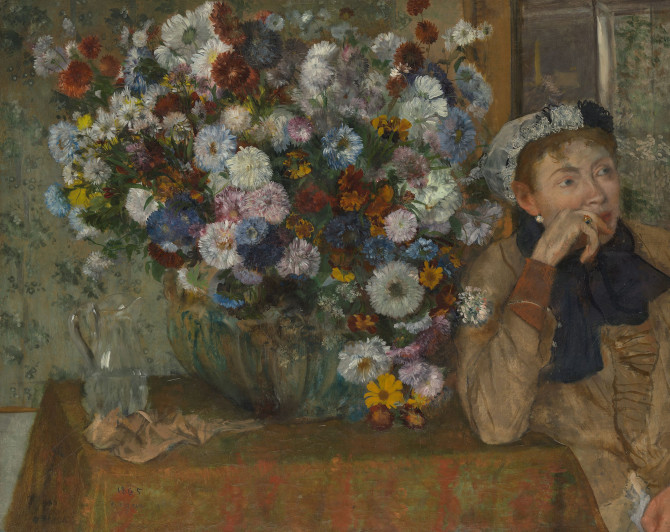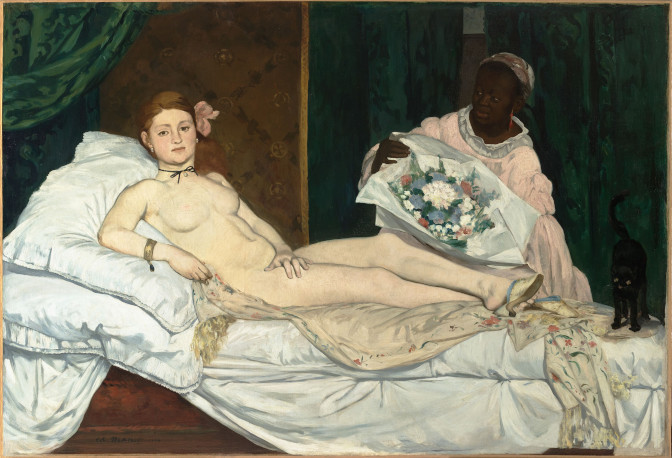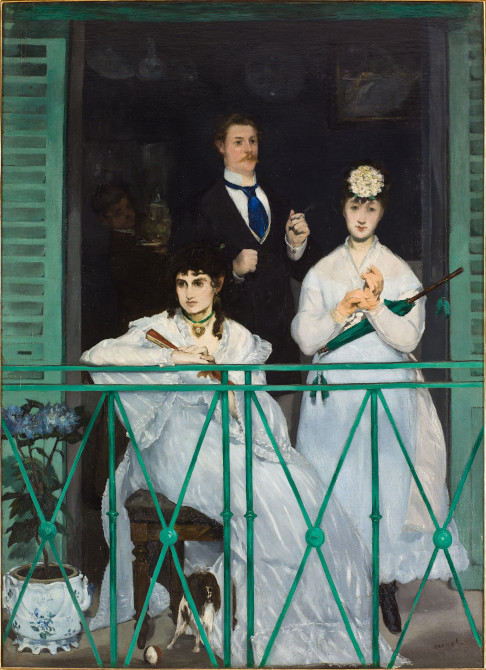Manet/Degas: A Tempestuous Love Affair at the Met

If there’s any validity to the adage that opposites attract, artists Edouard Manet and Edgar Degas are a perfect example. From a fortuitous encounter at the Louvre, through decades-long connections between families and friends, they shared an artistic rivalry and respect that reached beyond death itself. The Manet/Degas exhibition at the Metropolitan Museum of Art is a testament to that relationship.
Through more than 160 paintings and works on paper, visitors can compare the selections of these two great Impressionists and decide for themselves just how deeply they were influenced by one another. Manet, born January 23, 1832, and Degas, July 19,1834, were the eldest sons of upper middle-class Parisian families. But in looks and temperament, all similarity ends.

Manet, by his early 30s, was boisterously confident and seductive, with receding golden hair and deep-set eyes. Degas, the son of a Neapolitan banker, inherited the dark, soulful eyes of his Creole mother. Both men enjoyed the bustling café life, with Degas known for his dry wit, though essentially a loner. Manet, on the other hand, attracted adoration and easy liaison opportunities from his models. Degas was never quite at ease with women. He believed the artist must live apart. Sue Roe, in her excellent book, The Private Lives of the Impressionists, quotes Degas as remarking “I’d rather keep a hundred sheep than one outspoken girl.”
The exception to Degas’ reticence with the female sex was Mary Cassatt. At 28, she was accepted by the Salon. A wealthy Philadelphian, she was not conventionally pretty but impeccably dressed, approaching her work with the same discipline that Degas expected of himself. Though presumably a celibate relationship, he shared a great respect and friendship with her. Included in this exhibit is a painting of Mary with her sister at the Louvre, Visit to a Museum. She strikes an imperious pose, with unmistakable flair.

A highly popular draw within 13 sections of this massive comprehensive exhibit is the side-by-side portraits of café life. With In a Café (The Absinthe Drinker), Degas has placed his dissolute model, the actress Ellen Andree, alongside her downtrodden male partner. It’s a pose of urban isolation. Manet’s Plum Brandy (1877) focuses on the same model, both artists using the identical setting at the Nouvelle-Athenes. At close inspection, Manet’s solitary young woman is more whimsical and distracted than desolate.
Such unresolved expressions were often the case with Degas’ portraits. A perfect example can be found in a painting Degas did of Manet in a languorous pose while listening to his wife Suzanne playing the piano. Manet reciprocated with a small still life of prunes. Awhile later, visiting the Manets, Degas found his painting slashed, Suzanne now faceless. An ugly rift ensued between the two, which was eventually repaired.
The canvas, in its compromised state, is on display. We may never know the answer. Did Manet dislike the portrayal of his wife or simply the relaxed intimacy of the scene?

Four drawings of Manet by Degas—two from the Musée d’Orsay and two from the Met—are reunited with rare, related etchings. Degas’s recently conserved Family Portrait (The Bellelli Family), also from the Musée d’Orsay, is a monumental painting of his severe-looking aunt and her two young daughters holding a prominent position, with their father on the sidelines. It’s a beautiful evocation of the group.
Another highlight, making its first appearance in the United States, is the groundbreaking Olympia. It was the success de scandal at the Salon of 1865, described as a “triumph of vulgarity.” Some felt it got past the jury as a variant of Titian’s Venus of Urbino. A naked courtesan lies brazenly on her bed, attended by a Black servant and a black cat to boot, considered at that time a symbol of lewdness. Degas was represented by a small work on paper, War in the Middle Ages, but felt it was incorrectly described and hung, resolving he would do no more history paintings.

Yet another blatant example of Manet’s talent for shocking the public was his Le Dejeuner sur l’herbe, exhibited in 1863’s Salon des Refuses. His naked woman nonchalantly sits on a riverbank between two clothed men. The idea had been taken from classical works, the contemporary dress on the men making it all too real. One-hundred and sixty years later, the Met’s audience on my viewing seemed just as intrigued, if no longer incensed.
It's worth noting that one exhibit room is devoted to the role that Berte Morisot played in the lives of these artists. Berte and her sister Edma both exhibited landscapes the same year, and the Morisot family moved in the same circles as the Manets. It was inevitable that Manet and Degas would be taken by their beauty and talent.

Manet’s Le Balcon, a painting based on one of Goya’s, features a sulking yet stunning Morisot and two other friends. With the contrasting black and white touches, a signature style of Manet’s, it stands as a masterful work. If it was Manet’s younger brother Eugene that Morisot would marry, her affection for Manet rarely wavered. The most charming depiction of her in the exhibit is Berthe Morisot with a Bouquet of Violets. It stands as a kind of love letter to his subject -- her eyes as recalled by poet Paul Valery, “almost too vast” -- Manet forgetting their greenish color and painting them pure black.
Portraiture from both men is well represented. Outstanding examples are Degas’ The Old Italian Woman (1867) from his sojourn in Italy, as well as Manet’s The Spanish Singer (1860), which was his Salon debut.

This exhibition, in collaboration with the Musees D’Orsay and L’Orangerie, is so robust and comprehensive, each viewer will have to make his or her choices on where to focus. In addition to standout masterpieces by both artists, there are historical paintings, wartime depictions, beach scenes and seascapes, the latter luscious treats for any pair of eyes.
Degas’ colorful Beach Scene (1877) of a nanny combing a child’s hair displays a tenderness to please everyone. A later painting is presented in a patchwork state. Manet’s The Execution of Maximilian, in Degas’ possession after his friend’s death in 1883, was reassembled by the painter after it had been cut to pieces and dispersed. Evidence of Degas’ lasting affection for Manet can be found in the number of works he managed to accumulate after the loss of his friend.
Manet/Degas is an exhibition that emphasizes the indisputable role tht friendship—the human connection in a life—can play in great art.
Author Bio:
Sandra Bertrand is Highbrow Magazine’s chief art critic.
For Highbrow Magazine
Image Sources (courtesy of the Metropolitan Museum of Art):
- Edgar Degas, French, Paris 1834–1917 Paris In a Café (The Absinthe Drinker) 1875–76 Oil on canvas 36 1/4 × 26 15/16 in. (92 × 68.5 cm) Framed: 45 7/8 × 36 7/16 in. (116.5 × 92.5 cm) Musée d'Orsay, Paris (RF 1984)
- Edgar Degas, French, Paris 1834–1917 Paris A Woman Seated beside a Vase of Flowers (Madame Paul Valpinçon?) 1865 Oil on canvas 29 x 36 1/2 in. (73.7 x 92.7 cm) The Metropolitan Museum of Art, New York, H. O. Havemeyer Collection, Bequest of Mrs. H. O. Havemeyer, 1929 (29.100.128)
- Edouard Manet, French, Paris 1832–1883 Paris Berthe Morisot with a Bouquet of Violets 1872 Oil on canvas 21 7/8 × 15 15/16 in. (55.5 × 40.5 cm) Framed: 28 1/8 × 22 5/8 in. (71.5 × 57.5 cm) Musée d'Orsay, Paris (RF 1998 30)
- Edouard Manet, French, Paris 1832–1883 Paris Olympia 1863–65 Oil on canvas 51 3/8 × 75 3/16 in. (130.5 × 191 cm) Framed: 69 7/8 × 94 1/8 in., 264.6 lb. (177.5 × 239 cm, 120 kg) Musée d'Orsay, Paris (RF 644)
- Edgar Degas, French, Paris 1834–1917 Paris Monsieur and Madame Édouard Manet 1868–69 Oil on canvas 25 9/16 × 27 15/16 in. (65 × 71 cm) Frame: 32 15/16 × 36 5/16 × 3 9/16 in. (83.7 × 92.2 × 9 cm) Kitakyushu Municipal Museum of Art (0-119)
- Edouard Manet, French, Paris 1832–1883 Paris Plum Brandy ca. 1877 Oil on canvas 29 × 19 3/4 in. (73.6 × 50.2 cm) Framed: 34 1/2 × 25 1/4 × 2 1/4 in. (87.6 × 64.1 × 5.7 cm) National Gallery of Art, Washington, D.C., Collection of Mr. and Mrs. Paul Mellon (1971.85.1)
- Edouard Manet, French, Paris 1832–1883 Paris The Balcony 1868–69 Oil on canvas 66 15/16 × 49 3/16 in. (170 × 125 cm) Framed: 75 9/16 × 57 7/8 in., 136.7 lb. (192 × 147 cm, 62 kg) Musée d'Orsay, Paris (RF 2772)
Cover Photo: Edouard Manet, French, Paris 1832–1883 Paris On the Beach, Boulogne-sur-Mer 1868 Oil on canvas 12 3/4 × 26 in. (32.4 × 66 cm) Framed: 21 1/2 × 34 1/2 in. (54.6 × 87.6 cm) Virginia Museum of Fine Arts, Richmond, Collection of Mr. and Mrs. Paul Mellon































































































































































































































































































































